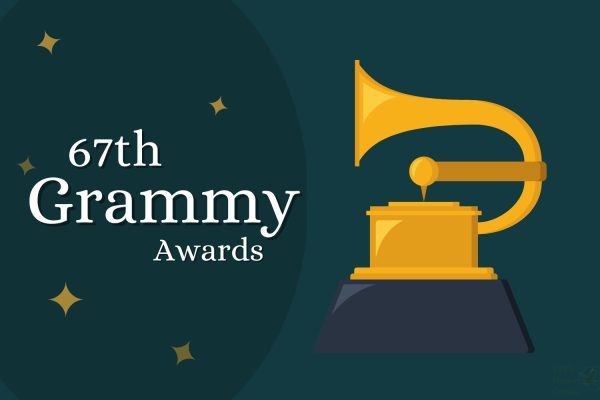Review: Taylor Swift shines as vocalist, song writer in new album, Evermore
Standing on a platform above the crowd, Taylor Swift performs her song “Delicate” for her Oct. 6, 2018, “Reputation” tour concert in the AT&T Stadium in Dallas. Since her Reputation tour, Swift has released three albums, including “Folklore” in July and “Evermore” last week. “Evermore is an excellent album and one of Swift’s best,” reporter Amanda Hare said in the attached album review. “Swift really shines with her songwriting skills and vocals, proving that she can continue to make it in the indie-folk genre, despite how far it is from her former country or pop genres.”
I walked out of my dance practice to 32 texts from my best friend.
Twelve were unreadable, just random letters she sent in an excited panic. Eight highlighted random topics. Three involved screenshots of Taylor Swift’s Instagram. Three were memes about Taylor Swift. And, six illustrated variations of “I’m dead” or “I’m deceased.” But, I got the gist of it: Taylor Swift was releasing a new album that night.
Only five months after releasing her eighth studio album, “Folklore,” musical artist Taylor Swift released her ninth studio album on Thursday, Dec. 11. Swift announced the album, “Evermore” on social media on Thursday morning and released it that night. “Evermore” comes as a “sister” record to her previous album, “Folklore,” which she released as a surprise album on July 24. Featuring 15 tracks, “Evermore” follows in Folklore’s footsteps, embracing an indie-folk genre incorporating vivid storytelling.
Swift also released a deluxe version of the album, featuring bonus tracks “right where you left me” and “it’s time to go.” The deluxe version can only be bought as a physical CD, and the bonus songs are not available on Spotify, Apple Music, or any other online streaming service.
“To put it plainly, we just couldn’t stop writing songs,” Swift said in a social media post announcing the album’s release. “I’ve never done this before. In the past, I’ve always treated albums as one-off eras and moved on to planning the next one after an album was released. There was something different with “Folklore.” In making it, I felt less like I was departing and more like I was returning. I loved the escapism I found in these imaginary/not imaginary tales. I loved the ways you welcomed the dreamscapes and tragedies and epic tales of love lost and found into your lives. So I just kept writing them.”
Typically, all of Swift’s albums are known as “eras” to her fans, keeping each of them as separate entities that are unconnected. However, Folklore and Evermore connect together integrating stories.
Swift said there were “17 tales” that were “mirroring or intersecting with one another.” For example, both songs “dorothea” and “‘tis the damn season” tell Dorothea’s story. Similarly “ivy” connects with “illicit affairs” off of Folklore, telling the story of an affair. “Marjorie” and Folklore’s “epiphany” tell the stories of Swift’s grandparents.
“I wanted ‘Evermore’ to represent fall and winter while ‘Folklore’ represents spring and summer,” Swift said in a Vevo comment prior to the “willow” music video’s release. “I’ve always wanted to do a two-part anthology that’s a collective body of work & it just kind of happened naturally.”
While they share the same genre, “Folklore” takes on a happier tone and “Evermore” takes on a much sadder, melancholy tone. The album’s songs deal with sorrowful topics such as “marriages gone bad,” breakups, mental health and regrets.
Overall, “Evermore” is an amazing album and one of Swift’s best albums. With the complex lyrics, metaphors, and deeper meanings, the songs illustrate stories and tales for listeners to enjoy. The range of the album allows the songs to be unique and distinguished from each other, not sounding too similar. Additionally, most songs feature a piano as the main instrument, which goes extremely well with the album’s tone.
“willow”
The first track and lead single of “Evermore” sets off with a whimsical tone. The beginning of the music video for “willow” seems to be a continuation of the story from “cardigan” off her eighth studio album.
In the song, Swift parallels the chorus of her 2019 song “Lover,” which has the lyrics, “can I go where you go? Can we always be this close?” with the new line “wherever you stray, I follow.” One other lyric Swift uses for reference is “but I come back stronger than a ‘90s trend,” which is about her previous lead single “cardigan.” One of the biggest trends in the 90s was a cardigan. Swift’s own song was followed by her own merch line including cardigans. She sent dozens of these cardigans to various celebrities to promote her album and the 90s trend. Swift also compares her relationship to a willow tree, where the roots are firm, but sometimes it looks out of control with “life was a willow, and it bent right to your wind.”
During a YouTube Q&A before the album’s release, Swift described the song, saying, “willow is about intrigue, desire and the complexity that goes into wanting someone. I think it sounds like casting a spell to make someone fall in love with you (an oddly specific visual).”
“champagne problems”
Swift starts off the second track of the album with a quiet, melancholy piano background melody while telling the story of a woman rejecting her significant other’s marriage proposal. In the chorus, she says “your hometown skeptics called it champagne problems.” The idiom of “champagne problems” means a problem that isn’t a big deal when compared to issues like poverty or war. The woman in “champagne problems” is criticized by her significant other’s family and friends for rejecting the proposal, saying her rejection stems from her “champagne problems,” which is interpreted to be a mental illness that others aren’t viewing as serious.
“gold rush”
In the third track, Swift references the 1849 Gold Rush in relation to jealousy regarding her boyfriend Joe Alwyn. She writes “I don’t like a gold rush,” and “I don’t like that anyone would die to feel your touch. Everybody wants you.” Swift fears that other women want Alwyn, like gold in a gold rush. Swift also compares Alwyn to gold in many other songs from past albums, most notably “End Game” of her sixth album Reputation and “Daylight” of her seventh album Lover.
“‘tis the damn season”
Following the sadder theme of the album, “‘tis the damn season” talks about reconnecting with an old lover over the holidays. With a softer, more vulnerable tone, this song is one of the best on the album. The bridge hits especially hard, with Swift saying “And the heart I know I’m breaking is my own, to leave the warmest bed I’ve ever known” describing how she knows the fling must end with the holidays and how she knows that she’ll regret leaving.
In a tweet, Swift clarified that the song is from the point of view of “Dorothea, the girl who left her small town to chase down Hollywood dreams – and what happens when she comes back for the holidays and rediscovers an old flame.” This directly connects “dorothea” and “’tis the damn season” on the album as intersecting stories.
“tolerate it”
In her song “tolerate it,” Swift features a soft piano melody along with various percussion instruments to add flavor and depth to the melody. “Tolerate it” describes a relationship with one person putting their all into it and the other not really caring. The narrator describes her pain in the chorus with “I know my love should be celebrated, but you tolerate it.”
“I decided on Track 5 because of the lyrics of ‘tolerate it’ and how it’s so visual and conveys such a specific kind of hurt,” Swift said in a Vevo comment prior to the “willow” music video release.
In Swift’s albums, Track 5 spots, usually one of the best songs on the album. are extremely important to the singer. For example, in the “Reputation” album, “Delicate” was Track 5 as well as a single with a music video. In the Lover album, “The Archer” was Track 5 and was a single on the album but also relatable to many viewers. “Folklore’s” Track 5 was “my tears ricochet” and was one of Swift’s favorite songs off the album. Of the “Fearless“ and “Red“ albums, Track 5 was “Dear John” and “All Too Well,” two of Swift’s most popular and saddest songs.
“no body, no crime” (feat. Haim)
Departing from the previous melancholy tone of the songs, Swift dives into a darker topic in “no body, no crime”— murder. The song starts immediately with sirens setting the ominous tone. Swift starts off singing about a woman named Este who suspects her husband is cheating on her. Throughout the song, Swift tells the story of how she suspects the husband murdered Este when she confronted him about his infidelity, but she can’t prove it. In revenge, Swift murders Este’s husband, yet never gets caught.
“I wrote ‘no body, no crime’ by myself,” Swift said in a Vevo comment prior to the “willow” music video release. “It was inspired by my obsession with true crime podcasts/documentaries, and I used one of my best friends’ names as the main character.”
The track features Haim, a pop-rock band made of three sisters who are close friends of Swift. Swift named the character “Este” after Haim member Este Haim. Swift said she chose Este because she is the friend she has “who would be stoked to be in a song like that.” After writing the song, Swift texted the Haim sisters and asked them to collaborate for the first time, despite being friends for years.
The song conveys its ominous tone extremely well and is very catchy. However, it doesn’t seem to fit into the theme of the other songs of the album. Stuck in between two sadder songs, the ambiance and topic of “no body, no crime” are slightly jarring to listeners. While a great song, it may not be placed in the right spot on the album.
“happiness”
Contrasting the name, Swift’s song “happiness” explains a saddening break-up in a relationship with a soft and mellow tone. It features references to the classic novel “The Great Gatsby.” The song dives into the suggestion that there are other girls after Swift, and that it is easy to regain happiness in a new relationship.
While it isn’t clear who this song is about, multiple sources suggest allusions to the novel “The Great Gatsby,” such as when Swift sings “I hope she’ll be your beautiful fool/Who takes my spot next to you.”
“dorothea”
With a sweet country tone, “dorothea” begins with a simple guitar intro featured in many of her tracks on “Evermore,” as well as older tracks from her earlier country career. It is suggested that “betty” is the sister song to “dorothea”.
“There’s not a direct continuation of the Betty/James/August storyline,” Swift said. “but in my mind Dorothea went to the same school as Betty, James and Inez.”
“coney island” (feat. The National)
This beautiful tune describes a romance coming to a near end. It features many callbacks to different tracks on different albums, such as “Delicate.” It is theorized that “coney island” is a rejected track from Reputation, an album created by Swift in 2017. This song begins with vocals from Swift, and it eases into soft low vocals from The National, a rock band who formed in 1999.
“ivy”
In her song “ivy,” Swift features a soft guitar melody reminiscent of her earlier music. Swift details the story of a wife having an affair and falling in love because this person understands her pain. In the chorus, Swift writes “my pain fits in the palm of your freezing hand taking mine, but it’s been promised to another.” Many listeners believe that “ivy” elaborates on the affair in “illicit affairs” from “Folklore.”
“cowboy like me”
What fans believe to be this album’s version of “Love Story,” Swift’s hit song depicting Romeo and Juliet off her second album, “Fearless,” “cowboy like me” features a fictional relationship between “two young con artists who fall in love.” Swift tells a tale of two people who find themselves in an unlikely relationship. These “bandits” originally want materialistic items, but that is changed when one night they dance together and fall in love. This song could also be related to “Getaway Car” from Swift’s album “Reputation,” where one lover discusses the mistakes made in a past relationship.
“long story short”
Contrasting the overall melancholy theme of the album, “long story short” features an upbeat melody and beat. The song tells the story of struggles throughout the past few years and how she’s ended happily now. The chorus features the lyrics “long story short, it was a bad time,” however, the song ends with the final lyrics “long story short, I survived.” Swift knows that while she’s struggled in the past with various dramas she’s happy now with Alwyn and has moved past it all. With the upbeat tone, the song is one of the best of the album and a favorite of many fans.
“marjorie”
In line with Track 13 “epiphany” from “Folklore,” which is about Swift’s grandfather, “Evermore’s” Track 13 is called “marjorie,” after Swift’s grandmother. Majorie Finlay was an opera singer, and she encouraged Swift to become a singer herself. In the lyric video for the song, there are multiple photos and videos including Swift and her grandmother together. Swift highlights memories she holds of her grandmother, including advice Finlay gave her that opens the song, “Never be so kind, you forget to be clever, never be so clever, you forget to be kind.”
On Twitter before the album’s release, Swift discussed the inspiration for “marjorie,” writing that the song is, “starring my grandmother, Marjorie, who still visits me sometimes, if only in my dreams.”
“closure”
In the 14th track of this album, “closure,” Swift features a mix of chaotic instrumentals and contradictory lyrics to convey the pain and denial that comes with the end of a relationship and getting closure. In the first verse, Swift writes, “And seeing the shape of your name still spells out pain,” but in the chorus, she contradicts the statement, saying “Yes, I got your letter. Yes, I’m doing better,” and “I don’t need your closure.” Throughout the song, Swift is denying her need for closure because the end of this relationship is still causing her pain.
“evermore” (feat. Bon Iver)
The final song of the album, “evermore,” is a collaboration between Swift and indie folk band Bon Iver. Swift and Bon Iver collaborated on “Folklore” with the song, “exile.” “Evermore” depicts the narrator’s journey from depression to hope, dealing with mental health like “happiness” and “champagne problems.” However, “evermore” deals with more healing than the other songs.
The song features a slower piano matching Swift’s softer singing. Bon Iver’s lead singer, Justin Vernon, joins in for the second chorus, bridge, and final chorus. Vernon sings with a higher voice than he did in “exile” and while slightly jarring at first, Vernon’s high voice and Swift’s softer singing blend well together for the bridge.
What was good with the album, what Swift could’ve done better
The album, as a whole, is amazing. The lyricism is so complex and meaningful with carefully crafted metaphors hiding throughout each song. The instrumentals and vocals were amazing, as well, though that is typical with Swift’s albums. While it should be hard for “Evermore” to live up to “Folklore,” which was a masterpiece in its own right, “Evermore” did not fall short of expectations.
The lyrics, specifically, are amazing. When digging deeper, listeners can find complex meanings in the simplest of lyrics. At first, listen, it’s hard to hear the deeper meaning of the lyrics, but when looking at the lyrics and even doing a little bit of research, listeners can find hidden meanings throughout the album. Every lyric is purposeful and impactful to the song, showing Swift’s talent as a songwriter.
However, the only improvement Swift could make on the album would be song placement. For example, Track 6, “no body, no crime,” is placed in the strangest spot. Sandwiched between two emotional songs, listeners almost have to skip it, no matter how great it is. It just doesn’t fit. It could be placed later in the album, perhaps close to “cowboy like me,” or Swift could have released it as a single or put it on the bonus album. There just isn’t the perfect spot for it.
Despite these problems, “Evermore” is an excellent album and one of Swift’s best. Swift really shines with her songwriting skills and vocals, proving that she can continue to make it in the indie-folk genre, despite how far it is from her former country or pop genres.
Your donation will support the student journalists of Prosper High School. Your contribution will allow us to purchase equipment and cover our annual website hosting costs.

Honors & Awards:
2022 TAJE Texas Journalist of the Year
2019, 2021 UIL State Headline Writing Champion Runner-Up
2022 UIL State Meet: 3rd place Headline Writing, 4th place News Writing, 7th place Editorial Writing
UIL Headline Writing Regional Awards:
2019: 2nd place
2020: 2nd place
2021: 3rd place
UIL Editorial Writing Regional Awards:
2020: 2nd place
2021: 4th place
20 Best of SNO publications
2021 National NSPA Story of the Year Honorary Mention
2021 National NSPA Top 10 Best of Show Podcast
2021 TAJE Best of Texas: Excellent Story Portfolio, Superior News-Feature Story, Honorable Mention Headline Writing
2021 TAJE Fall Fiesta: Superior Headline Writing, Superior Interview Podcast, Excellent Video News Story, Excellent Video Feature Story
2022 TAJE Best of the Best: 3rd place Online News Portfolio
2022 TAJE Best in Texas: Excellent Interview Podcast, Superior Story Portfolio, Honorable Mention News Story, Honorable Mention Feature Story, Excellent In-Depth Package, Excellent Entertainment Feature, Excellent Headline Writing
2022 NSPA Best of Show: 7th place Editorial Board Leadership, 4th place Podcast
2022 ILPC 6A Awards: 2nd place Sports Feature Story, 3rd place Feature Writing, 3rd Place Entertainment Review, 1st Place In-Depth News/Feature Package, 1st Place Photo Slideshow, 1st Place Video Story, 1st Place Multimedia Package, Honorable Mention Portrait, 3rd place Headlines
2022 Tops in Texas Awards: Photo Slideshow, Multimedia Package
2021 TAJE Student Advisory Council Member
2020-2022 PHS Newspaper Student of the Year
NSPA Student Journalist National Honor Roll
Quill and Scroll Honor Society Member

Honors & Awards:
2021 Best of Texas Newspaper/Broadcast
Excellent Photo Gallery
Excellent Feature Photo
Honorable Mention Sports Feature Story
1 Best of SNO publication
Quill and Scroll Honor Society Member
NSPA Student Journalist National Honor Roll 2021
2022 Best of Texas Newspaper/Broadcast
Honorable Mention Feature Story
2022 Fall Fiesta Excellent Podcast/Interview
Eagle Nation Times Third Place Best in Show in Large 6A Print News 2022

Honors & Awards:
2 Best of SNO publications
Dallas Morning News National High School Competition 1st place
Quill and Scroll National High School News Competition 2nd place
Quill and Scroll Honor Society Member
2020 TAJE Fall Fiesta: Superior Portrait, Honorable Mention News-Feature Photo
2021 TAJE Fall Fiesta: Excellent Sports Reaction, Honorable Mention Feature Photo
Interscholastic League Press Conference 2021 individual achievement awards:
Top in Texas: Feature photo
2nd: Photo Slideshow
3rd: Portrait
Honorable Mention: News Feature

Honors & Awards:
2 Lone Star Emmy awards for High School Fiction, 2023
4 Best Of Sno Publications, 2021-2023
3 Official Selections in All American High School Film Festival, 2021-2022
Vice President of the Junior Class 2021
Quill & Scroll 2021-present, Member
Winning Entry in Quill and Scroll 2021 International Writing Contest, Feature Writing, 2021
National Technical Honor Society 2020-present, Communications Officer
Student Council 2020-present, Member











![Freshman Polly Greaves created this updated version of the original graphic through Canva. Their next episode reviews a science fiction novel, 'Ender's Game.' "I feel like [Orson Scott Card] did a really good job incorporating feelings into his words and the plot," Greaves said, "which really made it a work of art because I believe that good books are books that can make you feel something."](https://eaglenationonline.com/wp-content/uploads/2025/02/EndersGame_Cover3-600x420.png)


